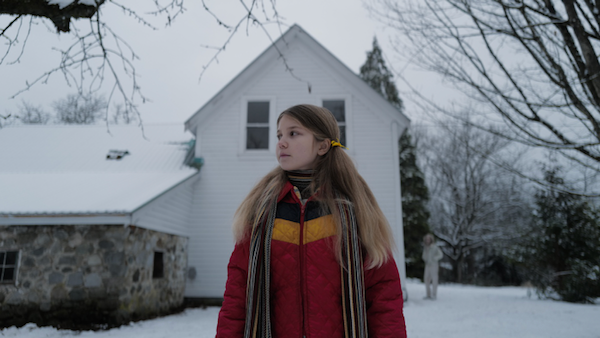Movie review by Greg Carlson
Even though he is only fifty years old, Osgood “Oz” Perkins has been linked to the legacy of his father’s titanic portrayal of Norman Bates for more than four decades – when he appeared onscreen in 1983 as the younger version of Bates in “Psycho II.” As an adult, Perkins has now put together a trio of attention-grabbing feature projects as writer-director (with another, an adaptation of Stephen King’s “The Monkey,” on the way). “Longlegs,” an unsettling and contemplative homage to key influences including “The Silence of the Lambs,” represents a big leap forward for Perkins. The movie’s intriguing mash-up of serial killer procedural and supernatural satanic panic, enhanced by Neon’s ace marketing of Nicolas Cage’s nightmarish title character, add up to Halloween in July.
Jonathan Demme’s 1991 phenomenon provides the foundational ingredients for “Longlegs.” As a protagonist echoing Clarice Starling, Maika Monroe plays Lee Harker, a young FBI agent working on a grisly case overseen by an older male mentor (Blair Underwood’s Carter). Harker, who can from time to time rely on a preternatural gift bordering on clairvoyance, does not cross paths with anyone like Hannibal Lecter, but Perkins leans in hard to the Buffalo Bill figure via Longlegs, a bizarre symbol of malevolence inhabited with the usual commitment by Oscar-winner and industry institution Cage. Longlegs, like Bill, is intimate with transfiguration. Longlegs is a maker, a builder, a creator.
Additionally, the physical presentation and androgyny of Longlegs align with the same aspects of Bill that continue to generate scrutiny and conversation centered on questions of transphobia and transmisogyny. In her sharp monograph on “The Silence of the Lambs,” Yvonne Tasker meticulously probes the multiple layers and complexities of the sexual politics projected by and upon Jame “Buffalo Bill” Gumb. As a rightly or wrongly perceived vessel for the stereotypical equating of queer identity with perversity, Longlegs has already inspired essays like the one by Samantha Allen for “Them,” in which the author argues that Perkins, in part reckoning with the personal impact of his famous father’s hidden homosexuality, fully understands how the movie’s queerness might be framed.
A parallel flurry of pieces on Cage’s monster – many of them emphasizing the actor’s longstanding commitment to taking creative risks – collectively write another chapter in one of modern cinema’s most singular and fascinating biographies (and if you have not done so already, do yourself a favor and pick up “Age of Cage” by Keith Phipps). Cage has notched plenty of oddballs, creeps, and weirdos, so it really says something that Longlegs vaults into unexplored territory. In “Longlegs” press, Cage has (for now), sworn off future serial killer roles. Along with the widely circulated story of Monroe’s 170 BPM heart-rate spike when seeing Cage in makeup for the first time (a publicist’s dream item if ever there was one), curiosity will drive ticket sales.
Even though it is not perfect, “Longlegs” is handily my favorite of the features directed by Perkins. Surprises are plentiful, but the movie’s central “big reveal” might be spotted with relative ease by horror hounds. Perkins takes some huge swings, but the fusion of so many familiar devices (including dolls, nuns, symbol-heavy cryptography, and conveniently close connections) is less impressive than the movie’s strengths: genuine dread, Kubrickian camera moves, meticulous production design, moody atmospherics, and a way of getting inside your head that lasts for days.
